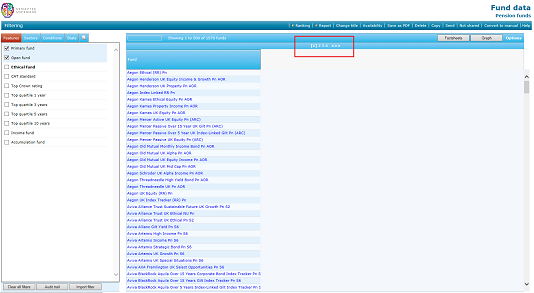Fund research starts at the same filtering/grid screen as product research. The principle is exactly the same as for product research: you can filter funds out by selecting features, and by specifying values for fields on the Stats tab (e.g. remove all funds with negative alpha). You can also build grids of data by clicking on field names, or by using the Field Chooser.

The example above shows a list of all unit trusts in the IMA UK All Companies sector which meet the following conditions, imposed via filters on the Stats tab: average annual performance over the last 5 years of at least 8% per year; an annual charge of at most 1.5%; at least £100 million under management; and at least 5 years of past performance data available. The grid includes a number of fields of data about the funds, and is sorted on past performance over the last 5 years.
Choosing the funds to include
The grid starts off empty when researching unit trusts, life funds, pension funds or offshore funds. You choose the funds you want to look at by selecting one or more sectors (from the Sectors tab).
In the example screenshot to the right, the grid is displaying all the unit trusts in either the UK All Companies or the Property sectors.

When researching the funds from a specific promoter, or linked to a specific contract, the grid starts off containing all the applicable funds. You can then filter the list down to specific sectors using the Sectors tab.
A manual fund list also starts off empty. You choose the funds you want to look at simply by using the Add a Fund link at the top of the grid.
Filtering which is switched on by default
When you start fund research, the system automatically adds filters which exclude closed funds, and which only look at “primary” funds. These default filters are illustrated by the screenshot to the right.
If a fund has more than one class of unit – e.g. both income and accumulation units – then only one of the types will be marked as primary(usually the accumulation units). The system automatically filters on this in order to remove “duplicates” of the same fund which will usually be irrelevant for your research.
If you do want to see both income and accumulation units, or you do want to see closed funds, you can simply remove these filters in the usual way by removing the ticks on the Features tab.
Limit on the number of funds displayed
Synaptic Research only displays a maximum of 500 funds at once in the grid. If the number of funds exceeds this (e.g. because you have selected lots of sectors) then the grid will be comprised of several ‘pages’. Click on the page numbers above the grid to show the 2nd 500, 3rd 500 etc, as shown in the screenshot below:

The system displays the first 500 records based on how you have chosen to sort the grid. Therefore, by default, it shows the first 500 in alphabetical order. In the example below, the grid has been sorted on 5 year performance (in decreasing order) and therefore the system is showing the top 500 performers.

